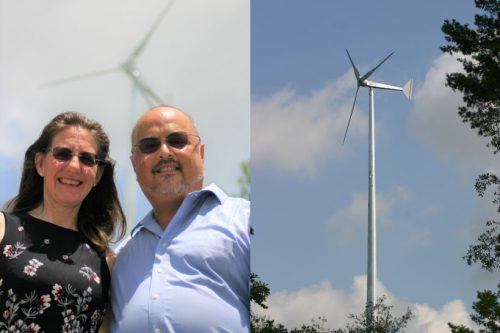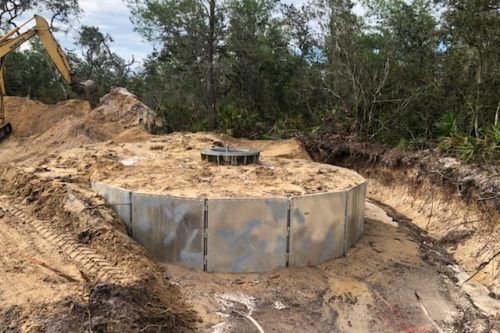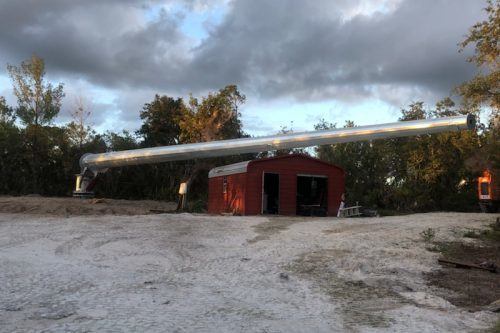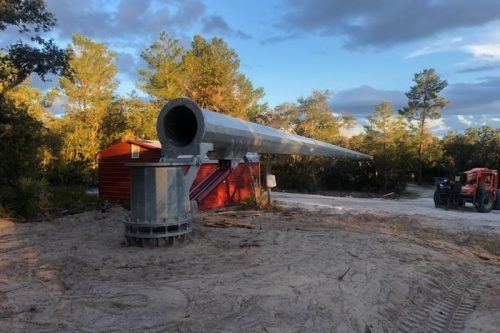Union Graduate Taps Nature’s Tools to Benefit the Planet

By Maurice A. Ramirez, D.O., Ph.D. (Union Ph.D. 2008, Retired Disaster/Emergency Medicine Physician)
People who want to reduce their carbon footprint might shop with reusable grocery bags, drive hybrid cars, or toss their newspapers in recyclable trash bins. But Maurice Ramirez, D.O., Ph.D. 2008, and his wife, Allison Sakara, N.P., P.H.R.N., have taken a much bigger step to lighten their load on the planet. On March 16, 2019, they erected a 90-foot-tall wind turbine on their Lake Wales, Florida property, the first ever in the state’s Polk County and the first noncoastal grid-tied wind turbine in the state.
The couple already had installed 81 solar panels on their home and improved its air-conditioning system to increase energy efficiency and indoor air quality.
“We then asked ourselves how we could generate power when it’s dark and stormy,” Maurice recalls thinking. “The answer? A wind turbine!”
Permits needed

While that seemed like a no-brainer, they first had to work with the county to write an ordinance to allow for a wind energy conversion system (WECS). Next was obtaining approval from county commissioners and the board of adjustments. They also had to overcome concerns about the tower’s height, operational noise, and any potential dangers to the environment. The couple lives in a nature conservancy that is home to a number of threatened species, so finding a WECS endorsed by respected experts as native-environment safe was essential. Fortunately, their love of research paid off and they were able to find a WECS endorsed by the Audubon Society as bird safe. They also received endorsements from the U.S. Fish & Wildlife Service and their closest neighboring property holders, The Nature Conservancy. Addressing noise output, however, later proved to be more problematic.
Solve noise issue
“After the wind turbine was installed, we discovered that it was noisier than the U.S. Department of Energy certification documents led us to believe,” states Maurice. The turbine sits atop a 90-foot monopole tower, like a “giant pinwheel” on a hollow stick. “And the problem was that this large, hollow monopole tower was acting like a giant megaphone,” he explains. The tower not only carried the noise down to ground level but it also amplified the noise. Thus, the very quiet 30 decibels generated by the turbine at the top grew to 90 decibels on the ground – the equivalent noise level of a riding lawn mower.


Fortunately, as an undergraduate at Florida State University, Maurice, a retired emergency room physician, studied sound physics, and Allison, a regulatory affairs specialist for medical devices, is an accomplished concert musician. Both recognized immediately that the root of the problem was resonance. They designed a system to mitigate resonance amplification in the hollow tower and installed vibration barriers between the turbine and its tower. “Our technology changes wind turbine towers from megaphones into mufflers,” Maurice describes. Their system lowered the noise level to between 38 and 45 decibels, achieving a reduction in perceived noise by more than 90 percent.
It’s a process that’s paying off. “We could not find any patents like our noise reduction technology,” he says. The result: Maurice and Allison now have a patent pending for their multi-modal approach for turbine noise mitigation and tower resonance reduction. That’s one of several patents they have pending or already hold, ranging from support of disaster responders to their innovative Natural Air E-Control system for HVAC energy conservation and indoor air quality improvement.
Credits Union with innovative thinking
Asked how they come up with their inventions, “We’re both medical disaster response specialists” replied Maurice. “We’re used to coming up with ‘MacGyver’ solutions,” referring to the famously unconventional problem-solving character of the CBS television series. “This is what made me a good emergency room physician and diagnostician. Its a thought process I learned from the 19 Nobel Prize laureates I studied under at Florida State University and developed during my doctoral program at Union Institute & University.” Such thought processes not only led the Union graduate to a successful career in emergency medicine and multiple patents, but also contributed to Maurice receiving the Lifetime Achievement Award in Disaster Medicine by the American Academy of Physician Specialists.
The fruits of that thought process are not limited to awards and inventions. Everyday benefits of their innovations make the energy efficiency of Maurice and Allison’s home exceptional. According to the U.S. Energy Information Administration, an efficient new home consumes 30 kilowatt hours (kWh) of electricity per 24-hour day, while the average older home consumes 85 kWh per day. The couple purchased an existing home which was found to consume 90 kWh per day. After completing the initial wave of energy efficiency measures, energy use fell below 70 kWh per day – and that was after adding a swimming pool, hot tub and large koi pond! Now, with an array of 81 solar panels and the wind turbine, Maurice and Allison generate 90 to 160 kWh per day (varies due to weather). That allows them to “bank” energy with the local power company against future needs, then annually sell energy back the remaining kWh to the local power grid.
Fourth most energy efficient home
According to the Residential Energy Services Network’s Home Energy Rating System (HERS), the nationally recognized system for calculating a home’s energy performance and the industry standard for that measurement, a home with a HERS Index score of 70 or below is considered ideal. The HERS score for Maurice and Allison’s home was originally 91, which is in keeping with many existing U.S. homes. After all the efficiency improvements, the house scored a remarkable negative 63. This score makes their home the most energy efficient renovated residence ever rated and the fourth most energy efficient home (renovation plus new construction) out of over two million homes rated since the program began.
So why did this couple invest so much time and money into energy efficiency and renewable energy systems? “For most people, including healthcare professionals, their home is their largest and most important investment,” replies Maurice. “Any improvements in energy efficiency that you make to your home not only save you money month-to-month, having a favorable HERS rating boosts your resale value. Some banks also promote ‘green energy’ projects, assisting you with targeted energy-efficiency renovation loans or rewarding your efforts with a reduction of your post-renovation mortgage rate.”
For this couple, their inventions and their renewable energy projects come down to a common motivation. “Allison and I believe that, as healthcare professionals, we have a responsibility to lead by example when it comes to global problems that impact individual and global health,” Maurice explains. “Even if you don’t invest in solar and wind power, just spending a few thousand dollars to improve your home’s energy efficiency and indoor air quality generates both local and global benefits.”
Be the world-changer you’ve always wanted to be. Enroll now in a Union Institute & University degree program that expands your knowledge and expertise. It all starts with You! And it all starts at Union Institute & University. Click to learn more.